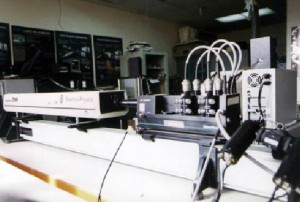
The present system is a commercial two color, four beam DANTEC fringe-type LDV system, operated in the backward scatter mode, with the general layout shown in the picture. Standard DANTEC 55× modular optics and a model Stabilite 2016 4W Special Physics Ar+ laser are mounted on a 2D, traversing system. Two separate LDV channels are formed by use of color separation of beams with wavelengths. They are 514.5 nm (green light) and 488.0 nm (blue light). These two beams form orthogonal fringes by means of a standard DANTEC two channel optical train. These two sets of fringes allow the simultaneous measurement of two orthogonal velocity components. The transverse velocity component is measured using the 488.0 nu beam, while the 514.5 nm beam measures a streamwise velocity component. A combined counter-type signalprocessor (Dantec model 57H00) with functions of counter, buffer interface and coincidence filter,which is nterfaced with a standard PC in the direct access mode, was installed. Typical results can beseen from the figure left and the apparatus layout and the abstract of the paper published.
Local heat transfer and velocity measurements in a rotating ribbed two-pass square channel with uneven wall temperatures
| Author Source Abstract |
S. S. Hsieh, Y. S. Wang and M. H. Chiang Journal of Heat Transfer, Transactions ASME v.119 n.4 Nov 1997 ASME pp. 843-848 0022-1481 Experimental data from both heat transfer experiments and LDV measurements in a rotating two pass oppositely rib-roughened square channel with uneven wall temperatures are extensively studied. Coriolis-induced secondary flows are shown to enhance local heat transfer over the trailing/leading surface in the first/second pass compared to a duct without rotation. Centrifugal bouyancy is shown to influence the heat transfer response with heat transfer being imposed on both leading and trailing surfaces as the wall-to-bulk fluid temperature difference is increased with other controlling parameters fixed. Further, LDV measurements verify the present and previous heat transfer measurements with and without rotation. |
